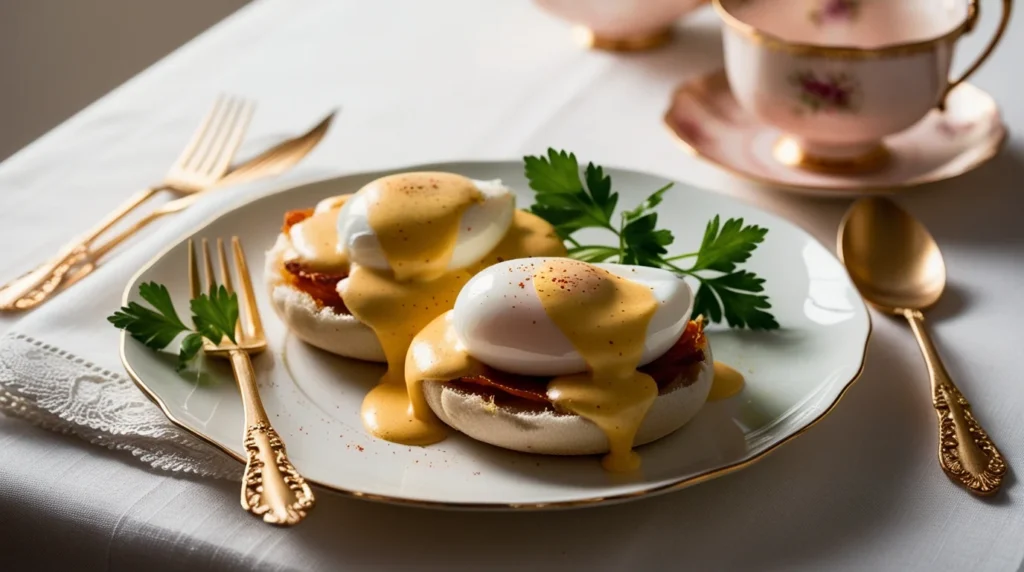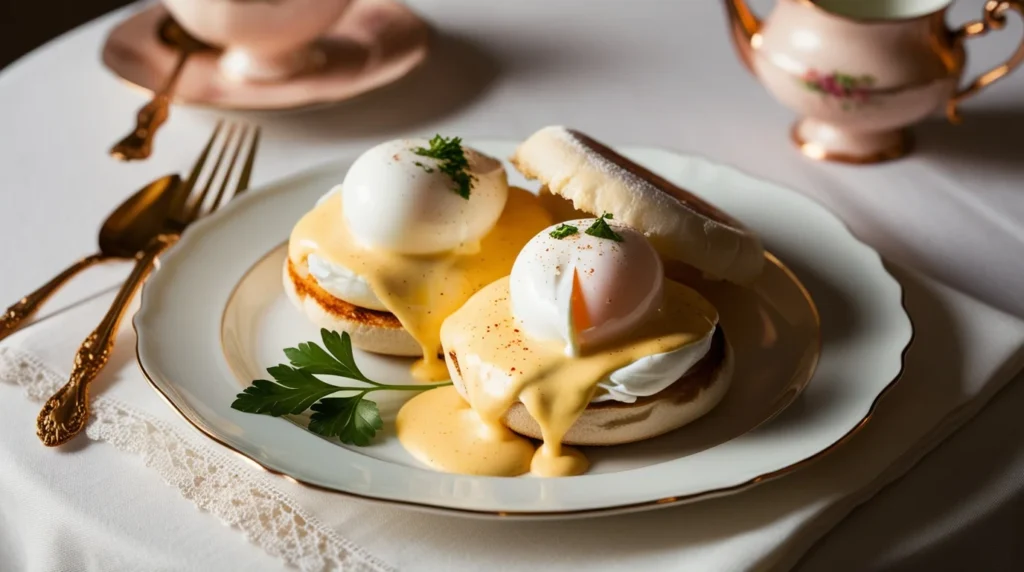Introduction and History of Eggs Benedict
Introduction
When it comes to brunch favorites, few dishes are as iconic and beloved as Eggs Benedict. This timeless meal, known for its rich, creamy hollandaise sauce draped over poached eggs, is a showstopper on any breakfast table. But have you ever wondered where this culinary masterpiece came from or how it became a brunch essential?
In this article, you’ll discover everything you need to know about Eggs Benedict, from its intriguing origins to the step-by-step process for making it at home. We’ll also explore the many creative variations that have developed over the years, proving that there’s more than one way to enjoy this classic. Whether you’re a foodie, a home chef, or simply someone looking to perfect your brunch skills, this guide will leave you feeling inspired and ready to whip up your own plate of perfection.
Let’s dive into the history of this legendary dish!
The Origins of Eggs Benedict
Who Really Invented Eggs Benedict?
The origins of Eggs Benedict are a topic of debate, with several competing claims about who deserves credit for this delicious creation. Two popular stories stand out, and each one adds an interesting twist to the tale.
One version credits Delmonico’s Restaurant in New York City as the birthplace of Eggs Benedict. The story goes that a regular patron of the restaurant requested something “different” for breakfast. In response, the chef combined poached eggs, bread, ham, and hollandaise sauce, unknowingly giving life to what would later become a culinary classic.
Another account points to a man named Lemuel Benedict, a Wall Street broker. In 1894, while nursing a hangover, he visited the Waldorf Hotel and ordered buttered toast, poached eggs, bacon, and hollandaise sauce. The hotel’s chef found the combination so innovative that he added it to the menu, swapping toast for an English muffin.
While it’s still unclear which story is 100% true, one thing’s for sure — both versions gave the world a dish we can’t get enough of.

How Eggs Benedict Became a Brunch Staple
At first, Eggs Benedict was a niche offering found in upscale restaurants and hotels. But as its popularity grew, it became a must-have on breakfast and brunch menus across the globe. Today, it’s practically synonymous with “brunch luxury” and is often associated with weekend indulgence.
So, how did it go from being a “special request” dish to a household name? It all comes down to taste and presentation. The silky smooth hollandaise sauce, combined with tender poached eggs and a warm, crisp muffin, creates a balance of flavors that’s hard to resist. And thanks to food photography and social media, it’s easier than ever to appreciate the beauty of this brunch classic.
Why the Name “Eggs Benedict”?
You might be wondering, “Why is it called Eggs Benedict anyway?” Well, the name is believed to come from either the wealthy Benedict family, who allegedly requested the dish at Delmonico’s, or Lemuel Benedict, whose “hangover cure” order inadvertently created culinary history.
Interestingly, the name “Benedict” also symbolizes “blessing” in Latin, which is fitting since many consider the dish a “blessed” addition to brunch menus. While we may never know for sure who the true “Benedict” is, we can all agree that it’s a name worth remembering.
What Makes Eggs Benedict So Popular?
It’s no surprise that Eggs Benedict remains a fan favorite. Its combination of flavors, textures, and sheer elegance is second to none. The tender egg yolk, when pierced, creates a natural sauce that mingles with the hollandaise, making every bite feel like a treat. It’s also versatile, which means people can customize it to their heart’s content.
This dish’s reputation has grown beyond fancy restaurants. Today, you’ll find it in cozy cafés, family brunch spots, and even home kitchens. With countless spins on the classic, like Eggs Florentine, Eggs Royale, and other global adaptations, Eggs Benedict has solidified its spot as a brunch icon.
How to Make Classic Eggs Benedict
Classic Eggs Benedict Recipe (Ingredients and Tools)
To make the perfect plate of Eggs Benedict, you’ll need fresh ingredients and essential kitchen tools. Here’s what you’ll need:
Essential Ingredients:
- Eggs — The fresher, the better for poaching.
- English Muffins — Toasted to golden perfection.
- Hollandaise Sauce — The rich, buttery sauce that ties it all together.
- Protein of Choice — Canadian bacon, smoked salmon, or sautéed spinach.
- Chopped Herbs (Optional) — Chives or parsley for garnish.
Required Kitchen Tools:
- Whisk — For the smoothest hollandaise.
- Slotted Spoon — To remove poached eggs without breaking them.
- Saucepan — For poaching eggs and making hollandaise.
- Heatproof Bowl — Whisk hollandaise sauce over simmering water.
- Toaster or Skillet — Toast muffins to crispy perfection.
Step-by-Step Instructions to Make Eggs Benedict
1. Making the Perfect Hollandaise Sauce
Hollandaise sauce is key to Eggs Benedict. Follow these steps for a smooth, creamy finish.
Ingredients for Hollandaise Sauce:
- 3 large egg yolks
- 1 tbsp fresh lemon juice
- 1/2 cup melted butter
- Salt and cayenne pepper (to taste)
Steps to Make Hollandaise:
- In a heatproof bowl, whisk egg yolks and lemon juice until pale and thick.
- Place the bowl over a pot of simmering water.
- Slowly drizzle in melted butter while whisking until smooth and thick.
- Season with salt and cayenne. Keep warm.
Avoid These Mistakes:
- Splitting (curdling): If the sauce overheats, remove from heat and whisk with cool water.
- Greasy texture: Add the butter slowly while whisking.
- Too thick or thin: Add water for thinness; whisk longer for thickness.
2. How to Poach Eggs Like a Pro
Perfect poached eggs have silky whites and runny yolks. Here’s how to achieve them.
How to Poach Eggs:
- Bring a saucepan of water to a gentle simmer (not boiling).
- Add 1 tbsp vinegar (it helps firm up egg whites).
- Crack each egg into a bowl for easy transfer.
- Stir the water to create a whirlpool.
- Slide the egg into the whirlpool.
- Let cook for 3-4 minutes until whites set but yolks stay runny.
- Remove with a slotted spoon and drain on paper towels.
Tips for Success:
- Use fresh eggs: Their firm whites hold shape better.
- Avoid boiling water: Keep it to a simmer.
- Don’t overcrowd: Poach 1-2 eggs at a time.
3. Cooking the Protein
The traditional choice for Eggs Benedict is Canadian bacon, but feel free to swap it for sautéed spinach or smoked salmon. Here’s how to prepare it.
How to Cook It:
- Heat a skillet over medium heat.
- Add bacon slices and cook 2-3 minutes per side until golden brown.
- Remove from skillet and keep warm for assembly.
Tips for Other Proteins:
- Use sautéed spinach for a vegetarian option.
- For smoked salmon, no cooking is required — just place it on the muffin.
4. Assembling the Classic Eggs Benedict
Once all components are ready, it’s time to assemble. Here’s how to stack them perfectly.
How to Assemble the Dish:
- Toast English muffins until golden brown.
- Place protein (like bacon or spinach) on each muffin half.
- Top each with a poached egg.
- Spoon warm hollandaise sauce over the egg.
- Garnish with chopped chives or parsley.
Pro Tips for Presentation:
- Serve on large white plates for a “restaurant-style” look.
- Add fresh fruit or a salad as a side for a complete brunch plate.
Common Mistakes When Making Eggs Benedict (And How to Avoid Them)
Even experienced chefs face challenges with Eggs Benedict. Here’s how to avoid the most common missteps.
1. Splitting Hollandaise Sauce
Problem: Sauce splits if it overheats or butter is added too fast.
Solution: Add butter slowly, and whisk constantly over low heat. If it splits, whisk in a spoon of warm water.
2. Overcooked or Undercooked Poached Eggs
Problem: Poached eggs that are too firm or too runny.
Solution: Poach eggs for 3-4 minutes in simmering water, not boiling. Use fresh eggs for better consistency.
3. Cold Eggs Benedict at Serving Time
Problem: Eggs and sauce cool down before serving.
Solution: Keep poached eggs in warm water and reheat hollandaise in a double boiler.
4. Dry or Soggy English Muffins
Problem: Muffins become too dry or too soggy.
Solution: Toast them right before assembly for a crisp, fresh texture.
5. Overcooked Protein
Problem: Proteins like bacon or spinach are too dry.
Solution: Cook them just before serving and keep them warm.
Creative Variations of Eggs Benedict
Popular Eggs Benedict Variations
Classic Eggs Benedict is a culinary icon, but it’s also a canvas for creativity. Here are some of the most mouthwatering versions you can try.
Eggs Florentine (with Spinach)
This healthier, vegetarian-friendly version replaces the protein with sautéed spinach. Lightly cook fresh spinach with olive oil and garlic, layer it on a toasted muffin, add a poached egg, and finish with creamy hollandaise.
Eggs Royale (with Smoked Salmon)
Eggs Royale swaps bacon for smoked salmon, offering a refined, silky twist. Just place smoked salmon on a toasted muffin, top with a poached egg, and drizzle with hollandaise. Garnish with dill or capers for extra flair.
Eggs Blackstone (with Bacon and Tomatoes)
This version adds crispy bacon and fresh tomato slices. Toast a muffin, stack it with bacon and tomato, top with a poached egg, and pour hollandaise sauce over it.
Crab Eggs Benedict (Chesapeake)
Seafood lovers will love Crab Eggs Benedict, made with golden crab cakes instead of bacon. Place the crab cake on the muffin, top with a poached egg, and finish with hollandaise.
Irish Benedict (with Corned Beef)
Irish Benedict features tender corned beef, sometimes served on soda bread or potato cakes instead of muffins. It’s a hearty, flavorful spin on the classic.
Huevos Benedictos (Mexican-Style with Chorizo and Salsa)
This spicy version swaps bacon for chorizo and hollandaise for chipotle sauce. Add a poached egg, salsa, and fresh avocado for a zesty, flavorful experience.
California Benedict (with Tomato and Avocado)
Light, fresh, and flavorful, the California Benedict features sliced tomato and creamy avocado. Add baby spinach for extra freshness, then layer with a poached egg and hollandaise.
Steak Benedict (with Steak and Béarnaise Sauce)
For a heartier meal, Steak Benedict replaces bacon with juicy steak medallions. It’s often served with béarnaise instead of hollandaise for an herbier, tangy flavor.
Southern Eggs Cochon (with Pulled Pork and Biscuit)
This Southern twist swaps the muffin for a buttermilk biscuit and bacon for tender pulled pork. The biscuit’s buttery flavor pairs perfectly with savory pulled pork and hollandaise.
Regional Eggs Benedict Flavors
Chefs worldwide have reimagined Eggs Benedict, adding local flavors and unique twists.
New Orleans’ Eggs Sardou
A New Orleans classic, Eggs Sardou replaces bacon with artichoke bottoms and creamed spinach. This regional twist blends French technique with Southern charm.
Global Influences on Eggs Benedict
- Asia: Uses teriyaki-glazed salmon or miso hollandaise.
- Europe: Adds béarnaise sauce for a refined, tangy finish.
- Caribbean: Swaps the muffin for fried plantains or jerk chicken.
These adaptations show how Eggs Benedict evolves with local flavors, offering endless possibilities for adventurous foodies.
How to Customize Eggs Benedict at Home
You don’t have to stick to the classic. Here’s how you can make your own unique version.
Swap Out Traditional Elements
- Base: Use bagels, waffles, or sweet potato rounds instead of muffins.
- Protein: Swap bacon for salmon, mushrooms, sautéed spinach, or tofu.
- Sauce: Try chipotle hollandaise, avocado hollandaise, or a vegan version made with cashews.
Make Vegetarian, Vegan, or Gluten-Free Versions
- Vegetarian: Use sautéed mushrooms, spinach, or tomatoes instead of bacon.
- Vegan: Use tofu “eggs” and cashew-based hollandaise. Swap muffins for gluten-free bread.
- Gluten-Free: Use gluten-free bread or sweet potato rounds as the base.
Tips, Serving Suggestions, and Nutritional Information
Chef’s Tips for Making Perfect Eggs Benedict
Mastering Eggs Benedict takes patience, but a few smart tips can make it much easier. Here’s how to perfect every component of this brunch classic.
1. Time-Saving Hacks
Pre-poach your eggs! Poach them ahead of time and store them in cold water. When ready to serve, reheat them for 30 seconds in hot (not boiling) water. It’s a game-changer, especially if you’re serving a crowd.
2. Keep Hollandaise Warm (Without Splitting)
Hollandaise sauce can easily split if overheated. Keep it warm by placing the bowl over a pot of warm water (not boiling) and stir it occasionally. If it starts to thicken too much, whisk in a teaspoon of warm water.
3. Pro Presentation Tips
Want Instagram-worthy Eggs Benedict? Stack the components with precision: muffin, protein, poached egg, and hollandaise drizzle. Garnish with fresh chives or microgreens for that “restaurant touch.” Use a white plate to let the colors pop, and wipe away any drips for a polished look.
Serving Suggestions for Eggs Benedict
Eggs Benedict is amazing on its own, but side dishes can make it feel like a complete meal. Here’s what pairs perfectly with it:
1. Side Dishes
- Breakfast Potatoes: Crispy roasted potatoes or hash browns add texture and heartiness.
- Fresh Salad: A light, mixed green salad with lemon vinaigrette balances the richness of the hollandaise.
- Fresh Fruit: Add color and sweetness with a side of fresh strawberries, oranges, or melon slices.
2. Drink Pairings
- Coffee or Tea: Bold coffee balances the rich flavors, while herbal tea offers a refreshing contrast.
- Juice or Smoothies: Fresh orange, grapefruit, or green smoothies add freshness and nutrition.
These sides create a well-rounded brunch experience, making Eggs Benedict the star of the meal.
Nutritional Information for Classic Eggs Benedict
Since Eggs Benedict features rich hollandaise and poached eggs, it’s definitely an indulgent dish. But you can make healthier swaps to lighten it up.
1. Nutritional Breakdown (Per Serving, Classic Version)
- Calories: Around 500–700 calories (depends on hollandaise portion)
- Protein: 22–25g (thanks to the eggs and bacon)
- Fat: 35–45g (mostly from the butter in hollandaise)
2. Healthier Swaps
- Hollandaise Substitute: Use a Greek yogurt-based hollandaise to cut fat and calories.
- Protein Alternatives: Use sautéed spinach, mushrooms, or smoked salmon for a leaner option.
- Base Swaps: Swap the English muffin for a whole-grain muffin, gluten-free bread, or sweet potato rounds for a nutritious twist.
By making these small changes, you can enjoy Eggs Benedict guilt-free while still savoring its delicious flavors.

Frequently Asked Questions (FAQs) about Eggs Benedict
What is the difference between Eggs Benedict and Eggs Florentine?
The main difference is the protein. Eggs Benedict uses bacon or ham, while Eggs Florentine replaces it with sautéed spinach. This makes Eggs Florentine a popular choice for vegetarians.
How do I keep hollandaise sauce from curdling?
Hollandaise sauce curdles if overheated or whisked too slowly. Keep it warm over low heat and whisk constantly while adding butter. If it splits, whisk in a teaspoon of warm water to bring it back together.
Can I make Eggs Benedict ahead of time?
Yes, you can! Pre-poach the eggs and store them in cold water. Reheat them in hot water (not boiling) for 30 seconds before serving. Hollandaise sauce, however, is best made fresh.
What’s the best way to reheat Eggs Benedict?
Reheat poached eggs in hot water for 30 seconds. To reheat hollandaise, use a double boiler and whisk constantly. Toast muffins fresh to keep them crisp.
Can I make a vegetarian version of Eggs Benedict?
Absolutely! Use sautéed mushrooms, spinach, or tomatoes as the base. You can also try avocado for a California-inspired version.
Why is vinegar used in poaching eggs?
Vinegar helps the egg whites firm up faster, keeping them from spreading in the water. A small splash is enough to make a big difference.
Conclusion
Eggs Benedict is more than just a brunch favorite — it’s a timeless classic that can be customized in endless ways. From the creamy hollandaise to the perfectly poached eggs, every bite feels indulgent. But the best part? You don’t need to be a pro chef to master it. With the tips and techniques shared in this guide, you can whip up a flawless plate at home.
Don’t be afraid to get creative. Try different proteins, bases, or sauces to put your personal twist on the classic. Whether you’re hosting brunch for friends or treating yourself on a Sunday morning, Eggs Benedict will always deliver elegance and flavor. Give it a try and discover just how satisfying it is to create this iconic dish from scratch.


